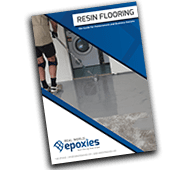Home › Advice › Know How › Knowhow
Five Keys to Industrial Non-Slip Epoxy Flooring
Have you ever applied an epoxy non-slip floor that was too smooth or too coarse in areas?
Over the years I have developed and specified countless types of non-slip flooring systems. Although there are many variations, I’ve found there are five keys to successful roller-applied, industrial non-slip epoxy flooring (aka “spread and sprinkle” non-slip flooring).
The five keys to industrial non-slip epoxy flooring
1. Flat substrate
With spread and sprinkle non-slip flooring, which relies on two films to sandwich a layer of non-slip particle/aggregate, you have to keep in mind the finished floor will reflect the surface profile. If you have a divot, there will be a low spot; if you have a crack, it might show through; the hills and valleys of an undulating floor will be visible. Getting the surface flat through levelling and/or patching will give you a much better result.
2. Film thickness
You might be able to stretch films out a little further on some jobs, but this is not one of them. Higher builds are generally required for non-slip epoxy flooring because there has to be enough resin to adhere to the substrate and bind all the particles together.
I’ve found a good figure to aim for is 60% particle coverage from the two coats, with the exposed tip providing the texture and wear surface. For quality industrial epoxy non-slip flooring, personally I wouldn’t put down less than 250-300 microns/10-12 mils for the basecoat, which works well with a 30 mesh particle.
The film thickness also has to be even. Too thick and you will end up with a smooth floor; too thin and the non-slip could be too aggressive or the particles too loose - to the point where they pop out. A consistent film gives consistent non-slip flooring.
3. Non-slip particle
A lot of contractors use quartz or sand, which has a Mohs hardness of 6-6.5 (diamond is a 10). That’s ok for light to medium traffic, but it’ll wear quickly with trolley or forklift traffic. For a harder aggregate, choose aluminium oxide or carborundum, which have a Mohs hardness of 9.
4. No substitution
The basecoats for industrial non-slip floors are chosen for a reason and substituting it can affect performance. Don’t get cheeky and swap it for a cheaper, thinner or stocked product.
5. Fully saturated non-slip
My recommendation is to never use anything less than a fully saturated layer of aggregate for industrial flooring projects. The most
common argument for sprinkling a layer instead of fully saturating is to make it easier to clean for the client. While this is
technically correct, if they're asking for such a thing then heavy-duty epoxy non-slip flooring is more than they need. Fully flooding
the floor increases durability and helps produce a consistent profile.

Non-slip flooring - particle use
If sprinkling is deemed the best approach, the success of the floor will be determined by how evenly the aggregate is broadcast. There are
many techniques for doing this, however I find grabbing a “knuckle full” (as opposed to a hand full) and lightly tossing into the air for
the particles to settle randomly on the film is the best way.
As a rough guide to consumption, fully saturated floors based on 2 x 250-micron/2 x 10 mils coats typically use anywhere between 1-1.5kg per
m2/0.2-0.3lb per ft2 of aggregate, while light sprinkling can be as little as 50-100g per m2/0.16-0.32oz
per ft2. The thicker the films, the more aggregate you’ll need to add.
The right habits are everything!
It may sounds like a lot to remember, but it really isn't. It is just about developing the right habits from scratch. For those unfamiliar
with non-slip epoxy flooring and looking for some step-by-step guidance, the Bronze Card online
epoxy training course covers
it in much greater depth.
So, how did my keys to success relate to the last non-slip job you completed?
-
Products - Use quality epoxy rollcoats and non-slip particles that can handle harsh industrial conditions:
- Ezypoxy Rollcoat - Tintable Epoxy Rollcoat
- Jaxxon 1505 - Industrial Epoxy Floor Coating
- Jaxxon 1525 - High-strength Industrial Epoxy Floor Coating
- Resin Grip HD - Broadcast Aggregate for Non-slip Flooring
-
Systems - Specify specialist industrial non-slip flooring systems with proven performance:
- Resin Grip - Protective Non-slip Flooring System
-
Learning - Learn more about non-slip flooring, and much more, with our online courses:
- Epoxy Flooring How To Videos
- Epoxy Flooring Short Courses
- Bronze Card Course
- Silver Card Course
-
Ask a question - If you have any questions you'd like to ask us about this topic, hit the support button below:
_800x271a.png)
